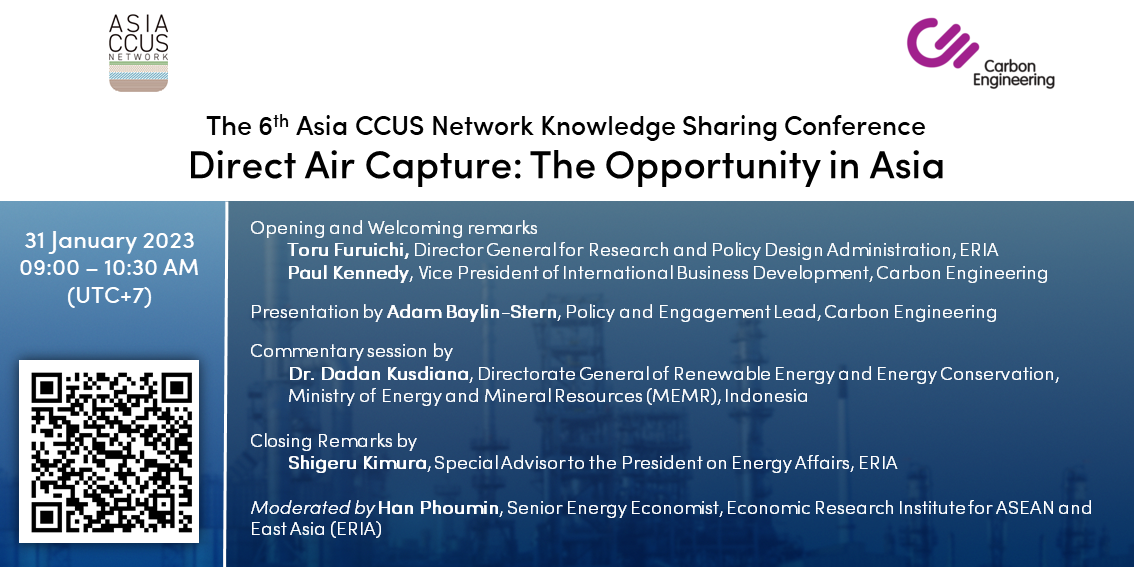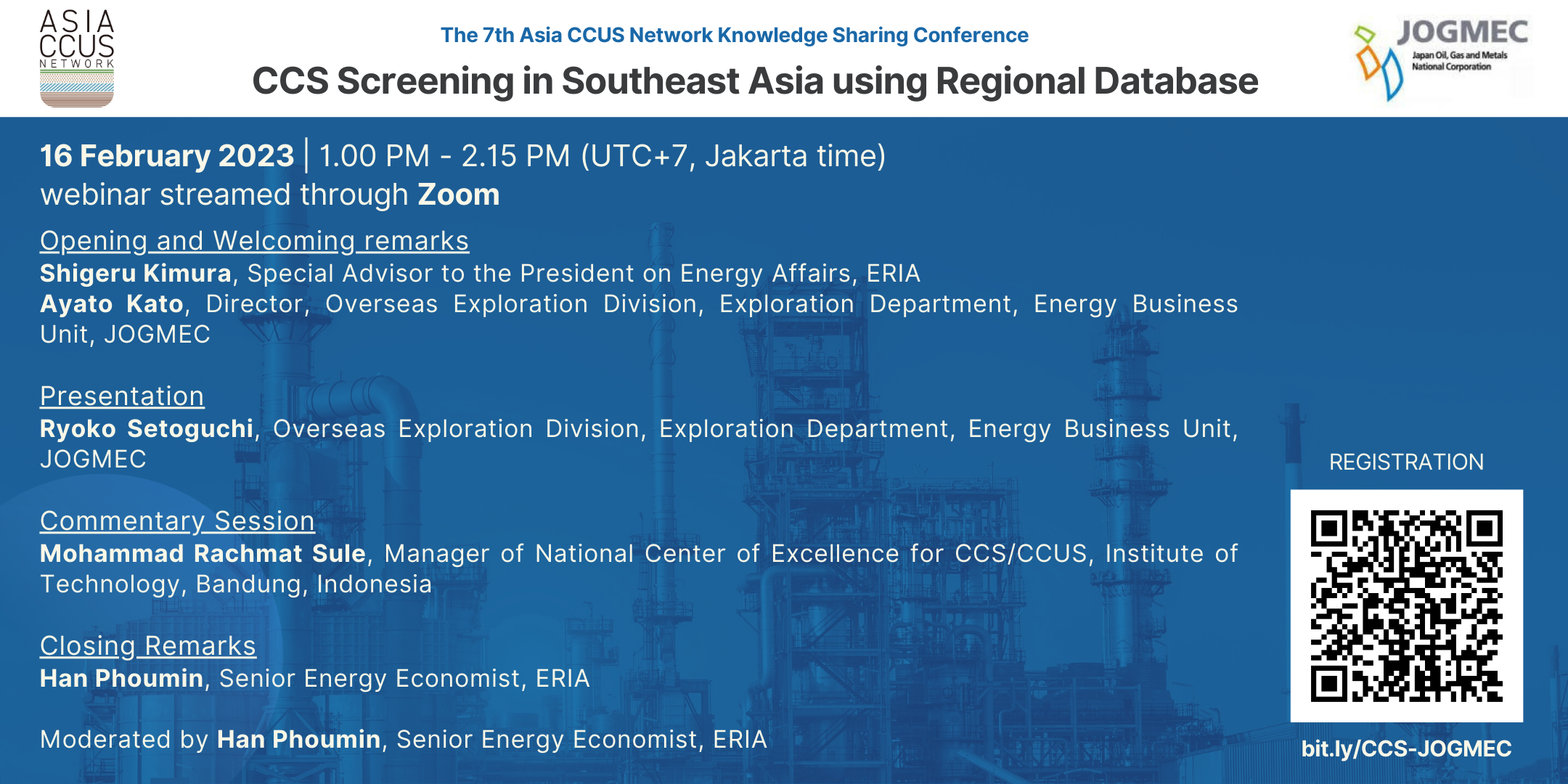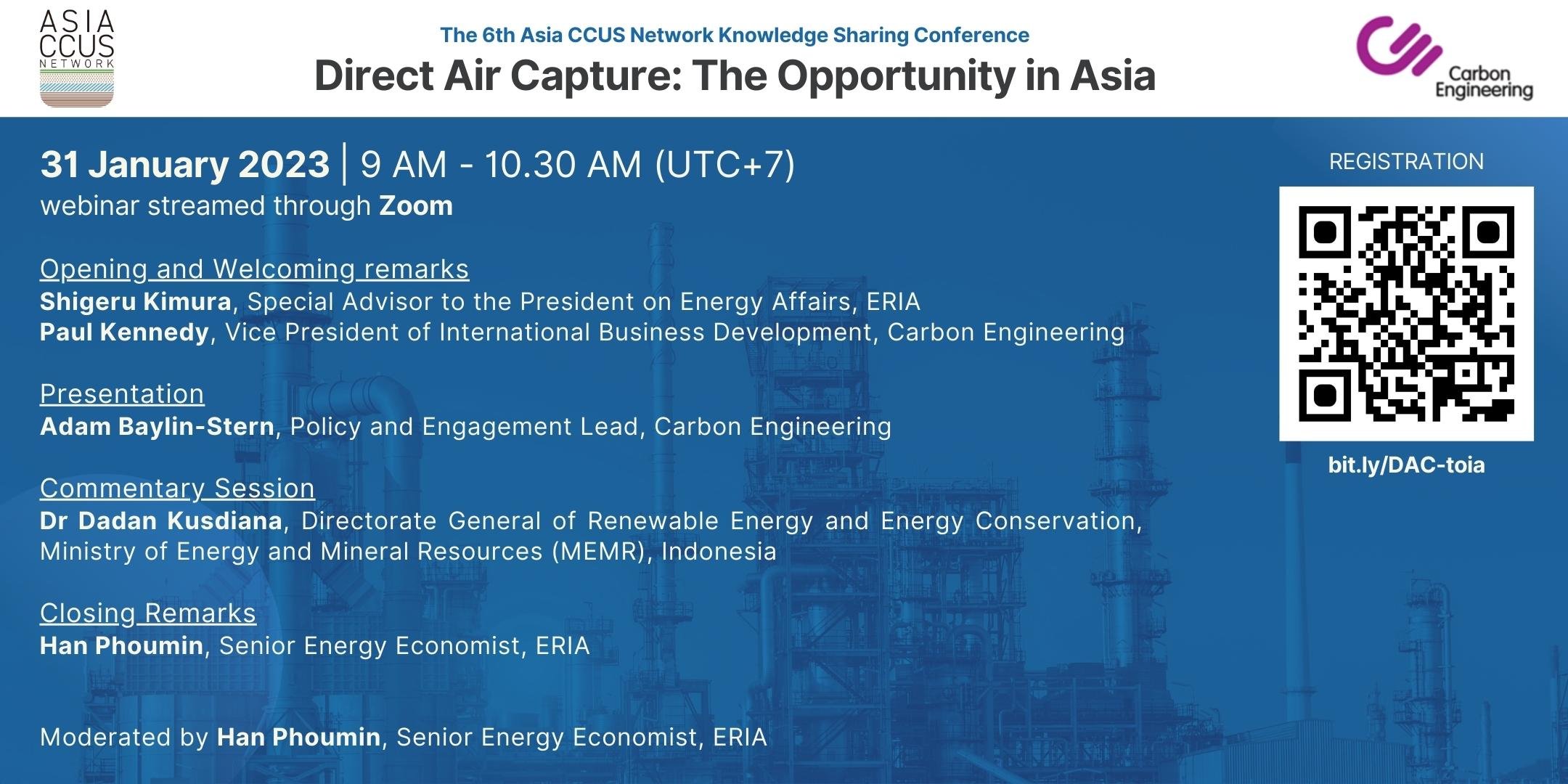Upcoming events.
.png)
The 8th Asia CCUS Network (ACN) Knowledge Sharing Conference
‘Huff and Puff CO2 EOR: Small Field Solution to improve production and reduce emission’
Thursday, 13 April 2023 | 13:00 – 14:30 (UTC+7), 15:00 – 16:30 (UTC+9) - Webinar via Zoom
There are two type CCS EOR or EGR, CO2 flooding and Huff and Puff (HnP). During the CO2 flooding mode, CO2 is injected through one injection well, and oil and gas will be produced from one production well. Injected CO2 will break through from the injection well to the production well along the fractures or high permeability channels in reservoirs and improve the recovery factor of oil and gas in place. Meanwhile, CO2 HnP uses one well as both injection well and production well to avoid gas break through. The HnP process consist of three stages process: gas injection stage, well soaking stage, and production stage. HnP has been known since 1960s, but the development of the technology is relatively slow due to available easier and cheaper to produces resources and lack of CO2 resources. However, since most oil fields depleted, HnP bring a new alternative to bring small fields and unconventional resources into production possible. Former studies indicated that CO2 HnP has the advantages of strong pertinence, short cycle, and fast capital recovery. Those advantages could bring HnP good solution for increasing oil and gas production and reducing CO2 emission in Asia.
Pertamina of Indonesia has conduct research and pilot projects for HnP CO2 EGR and EOR for several times kindly sharing the experiences and sharing a collaborative opportunity for promoting CCUS in Asia.
The conference will promote knowledge-sharing on the HnP CCUS technology, challenges and opportunities and the policy and regulation needed to support its massive deployment. It is co-hosted by ACN and Pertamina. It will include presentation of the Pertamina experiences in preparing suitable fields, decision to implement HnP technology and lesson learned in its endeavor, and potential collaboration may arise.
Agenda
(UTC+7, Western Indonesian Time)
13:00 – 13:15 Opening and Welcoming remarks
Shigeru Kimura, Special Advisor to President on Energy Affairs, ERIA
13:15 – 14:00 Presentation “Huff and Puff CO2 EOR: Small Field Solution to improve production and reduce emission” by PERTAMINA
Merry Marteighianti, Vice President Research & technology Innovation
Debby Halinda, Expert, Research & technology Innovation
(Moderated by: I Gusti Suarnaya Sidemen, ERIA Expert on CCS/CCUS)
14:00 – 14:10 Commentary session - Project Collaborator by Kazuaki Mikami, Reservoir Engineer/Deputy Director, Subsurface Division, Hydrogen and CCS Project Department, JOGMEC
14:10 – 14:25 Open discussion Session
14:25 - 14:30 Closing Remarks by Han Phoumin, Senior Energy Economist, ERIA
The 7th Asia CCUS Network (ACN) Knowledge Sharing Conference
‘CCS Screening in Southeast Asia using Regional Database’
Thursday, 16 February 2023 | 13:00 – 14:15 (UTC+7), 15:00 – 16:15 (UTC+9) - Online Conference
Carbon dioxides capture and storage (CCS), a technology that captures and stably stores carbon dioxide deep underground for long periods of time, is considered to play an important role in achieving decarbonization. To select suitable CO2 storage sites for CCS, subsurface data such as seismic and well data are often used for site screening and selection but evaluating wide region using subsurface data takes time. Furthermore, since availability of subsurface data is normally not uniform, it is sometimes difficult to obtain evaluation with uniform criteria and data for the whole area of interest.
Therefore, to enable the screening study over a broad area using uniform criteria, JOGMEC have conducted the assessment for CCS screening in Southeast Asia using regional geological database (Neftex by Halliburton). A regional scale assessment was conducted for the entire Southeast Asia region as Phase 1 and a basin scale assessment as Phase 2. In Phase 1, basins of Southeast Asia were ranked based on conditions of suitability. Considering Phase 1 result and the location of CO2 emission sources, twenty-three target formations/intervals in thirteen sedimentary basins were selected for Phase 2. The results of Phase 2 were summarized as a fairway map showing the geological suitability of CCS and CO2 storage capacity estimated based on simple volumetric method for each target formation/interval. The results of Phase 1 are consistent with the location of planned CCS & CCUS projects in Southeast Asia, indicating the potential utility of this methodology for site screening at the regional scale. Phase 2 methodology could be used to identify CCS suitable areas by formation and to calculate rough estimation of the storage volume. The methodology used in this study allows for consistent site screening for CCS over a wide area.
This conference aims to share the JOGMEC’s experience on the CCS screening methodology and the assessment results in the Southeast Asia.
Agenda
(UTC+7, Jakarta Time)
13:00 – 13:10 Opening and Welcoming remarks
Shigeru Kimura, Special Advisor to President on Energy Affairs, ERIA (3-5 minutes)
Ayato Kato, Director, Overseas Exploration Division, Exploration Department, Energy Business Unit, JOGMEC (3-5 minutes)
13:10 – 13:45 Panel Discussion on “Regional CCS Screening Using Regional Database”
by Ryoko Setoguchi, Overseas Exploration Division, Exploration Department,
Energy Business Unit, JOGMEC
Moderator: Han Phoumin, Senior Energy Economist, ERIA
13:45 – 13:55 Commentator by Mohammad Rachmat Sule, Manager of National Center
of Excellence for CCS, CCUS - Institute of Technology Bandung (ITB),
Indonesia.
13:55 – 14:10 Open discussion Session
14:10 - 14:15 Closing Remarks by Han Phoumin, Senior Energy Economist, ERIA

The 6th Asia CCUS Network (ACN) Knowledge Sharing Conference
“Direct Air Capture: The Opportunity in Asia”
Tuesday, 31 January 2023 | 09:00 – 10:30 (UTC+7) - Online Conference
Carbon Capture, Utilisation and Storage (CCUS) technologies are expected to play an important role in supporting clean energy transitions across Asia as an emissions reductions pathway for fossil-fuel intensive power and industry sectors. Direct Air Capture (DAC) technology is expected to support the transition with carbon removals to counterbalance residual emissions through technologies.
Many countries around the world have committed to the energy transition as reflected in their NDCs although some countries have yet to pledge any specific target year for carbon neutrality. However, not only developed countries have committed to carbon neutrality, but many countries in the developing world also fully committed to making the energy transition from a fossil fuels-based energy system towards cleaner and greener energy systems in which more renewable energies such as wind, solar, hydropower, biomass, and other clean fuels will have a larger share in the energy mix.
Unlike capturing emissions from industrial flue stacks, DAC technology captures carbon dioxide (CO2) directly from the atmospheric air around us, through a series of chemical reactions, delivering it in a pure compressed stream suitable for storage or use. This can help counteract CO2 emissions that are technologically challenging or prohibitively expensive to abate and address the large quantities of CO2 emitted in the past that remains trapped in our atmosphere. Leading international organizations such as the Intergovernmental Panel on Climate Change (IPCC) and International Energy Agency (IEA) are highlighting the importance of high integrity, technology-based carbon removals in pursuit of these goals. The IPCC Sixth Assessment Report on mitigating climate change has stated that the direct removal of carbon dioxide from the atmosphere is now “unavoidable”; in order to reach our climate targets, we must both reduce emissions at source and also remove carbon dioxide from the atmosphere at large scale. The remaining emissions from fossil fuel combustion including power generation or industrial facilities that use fossil fuels, will need to be captured and transported to storage through CCUS technologies or through the Direct Air Capture technologies (around 2 Gt CO2 are removed in 2050 by technology-based CDR in the IEA’s Net Zero Scenario).
The conference will promote knowledge-sharing on the DAC technology and the policy and regulation needed to support its large-scale deployment. It is co-hosted by ACN and Carbon Engineering, a Canadian climate solutions company, which has been focused since 2009 on developing DAC technology and commercializing it globally at large-scale, working alongside local partners. It will include presentation of the company’s technology and business developments, and discussion of the opportunity that exists to deploy DAC in Asia as it accelerates its clean energy transition. The session will also explore possibilities for countries to pursue international and regional co-operation opportunities to be suppliers of high integrity CO2 removal, and to unlock associated economic and job opportunities
Agenda
(UTC+7, Western Indonesia time)
09:00 – 09:15 Opening and Welcoming remarks
Shigeru Kimura, Special Advisor to the President on Energy Affairs, ERIA
Paul Kennedy, Vice President of International Business Development, Carbon Engineering
09:15 – 10:00 Panel Discussion on “Direct Air Capture: the opportunities in Asia”
Moderator: Han Phoumin, Senior Energy Economist, ERIA
Panelist: Adam Baylin-Stern, Policy and Engagement Lead, Carbon Engineering
10:00 – 10:10 Commentary Session
Dr Dadan Kusdiana, Directorate General of Renewable Energy and Energy Conservation, Ministry of Energy and Mineral Resources (MEMR)
10:10 – 10:25 Q&A
10:25 – 10:30 Closing Remarks
Han Phoumin, Senior Energy Economist, ERIA



